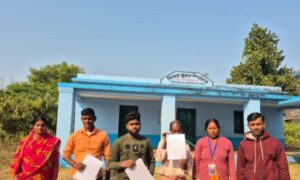
India is suffering from the worst water crisis in its history and millions of lives and livelihoods are under threat as the Composite Water Management Index (CWMI) showed. NITI Aayog instituted the CWMI stated that 600 million people in India face high to extreme water stress in India. About three-fourths of the households in the country do not have drinking water at their premise. With nearly 70 per cent of water being contaminated, India is placed at 120th amongst 122 countries in the water quality index.
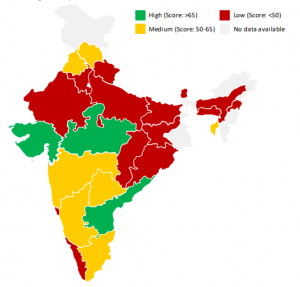
Source: Composite Water Management Index: 2018, NITI Aayog
It is the alarming situation and the governments must take immediate actions to cope with such challenges. The Composite Water Management Index is popularly known as the Water Index. NITI Aayog through the Water Index has ranked states on composite water management which comprises 9 broad sectors, with 28 different indicators like groundwater, restoration of water bodies & irrigation.
Categorization of States:
For the CWMI, the reporting states were also divided into two special groups – Non-Himalayan states and North-Eastern and Himalayan states, to account for the different hydrological conditions across these groups.
Classification of States for CWMI
| Non-Himalayan
states |
Andhra Pradesh, Bihar, Chhattisgarh, Goa, Gujarat, Haryana, Jharkhand, Karnataka, Kerala, Madhya Pradesh, Maharashtra, Odisha, Punjab, Rajasthan, Tamil Nadu, Telangana, Uttar
Pradesh and West Bengal |
| North-Eastern
and Himalayan States |
Arunachal Pradesh, Assam, Himachal Pradesh, Jammu and Kashmir, Manipur, Mizoram, Meghalaya, Nagaland, Sikkim, Tripura and Uttarakhand |
Source: Composite Water Management Index: 2018, NITI Aayog
According to the CWMI, Gujarat maintained the top slot in composite water management in India, followed by Madhya Pradesh, Andhra Pradesh, Karnataka and Maharashtra, in a first of its kind ranking of states on the management of water. Actions were taken by best performing states like Gujarat, Madhya Pradesh and Andhra Pradesh signify that corrective action has begun in areas that need it the most and this reflects on their position on the Water Index.
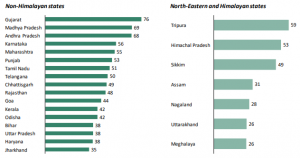
Source: Composite Water Management Index: 2018, NITI Aayog
Scope and Structure of the Index
According to the NITI Aayog, the CWMI is envisioned to bring about much-required improvements in water resource management and conservation in India in a coherent and collaborative manner. As the reported stated, the Index will be a public platform that provides an annual snapshot of the water sector status and the water management performance of the different states and UTs in India. The Index will measure both the overall progress made by states in water management and the incremental improvement in performance across time.
Non-Himalayan States:
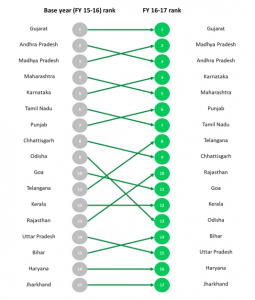
Source: Composite Water Management Index: 2018, NITI Aayog
North-Eastern and the Himalayan States:
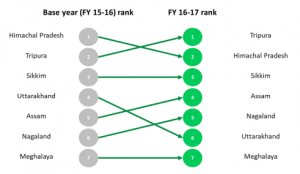
Source: Composite Water Management Index: 2018, NITI Aayog
Themes and Indicators
The Index comprises nine themes (each having an attached weight), covering groundwater and surface water restoration, major and medium irrigation, watershed development, participatory irrigation management, on-farm water use, rural and urban water supply, and policy and governance. The themes are further sub-divided into 28 indicators.
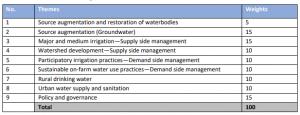
Source: Composite Water Management Index: 2018, NITI Aayog
The Independent Validation Agency (IVA) -IPE Global- reviewed the data (indicator-wise) entered for each state/UT in the NITI Portal by validating it against the source data, published data, supporting documents shared by the state, and other sources in the public domain.
It is imperative for India to boost treatment of wastewater, both to ensure that downstream areas are not contaminated, and to enable the reuse of water. By reusing water, India can significantly increase the utility gained out of all available water. The report showcased several successful case studies from India and several countries in order to put various things in a perspective.
NITI Aayog claims that the establishment of the Composite Water Management Index (CWMI) is a landmark achievement in the context of India’s water management. The Index can help reinforce the principle of ‘competitive and cooperative federalism’ in the country and enable innovation in the water ecosystem.
The CWMI is first comprehensive and integrated national dataset for water in India. The conceptualization, development, and operationalization of this Index have involved close collaboration between several levels of national, state, and local policymakers and government officers. The Index is expected to promote the spirit of ‘competitive and cooperative federalism’ in India and ensure sustainable and effective management of water resources.


